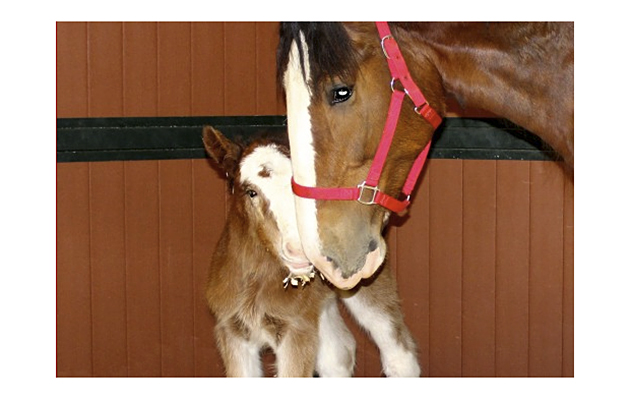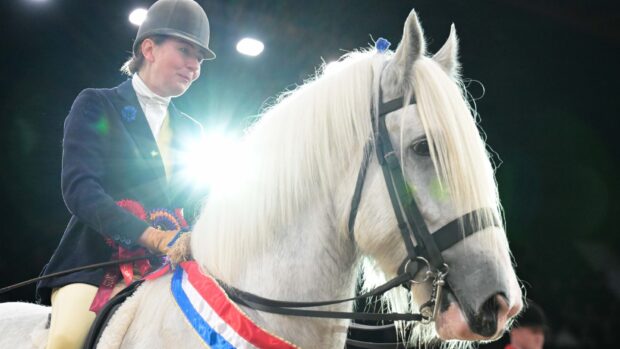The Clydesdale horse is among the tallest equines in the world. Known for its height and strength but also a certain elegance, the Clydesdale is a heavy horse with style that is renowned the world over, thanks to its fame in the Budweiser commercials. Yet the breed is at risk of extinction.
They vie with the Shire horse and Belgian Draft in terms of the title, “world’s biggest horse”. Although they are tall (typically at least 17hh), they are lighter than these other large breeds due to their slighter frame.
As with any horse, there is no ballpark figure on how much a Clydesdale costs. Prices are dependent on age, pedigree, training, temperament, conformation, ability and so on.
In this article: Looks and conformation | History | Famous Clydesdales

Clydesdales are renowned for their pulling power
Looks and conformation
- Big ears and an open forehead; broad between the eyes with a flat profile
- The muzzle should be wide, with large nostrils
- A well-arched, long neck set on a sloping shoulder, with high withers
- The back should be strong with good depth of well-sprung rib
- Limbs with strong, flat bone; legs set close together. Hock to pastern is comparatively long, with no gaskin
- Abundant white, silky feather
- The Clydesdale normally stands between 17hh-18hh – mares are typically smaller than stallions and geldings
- Colours: bay and brown with white markings are prevalent; black, roan and chestnut are less common. White markings are characteristic, and nearly all Clydesdales have a white blaze and long white socks, often running up to the belly
- They typically have a high-stepping, showy action, which gives the impression of power, quality and weight, not bulk. They are one of the most elegant of the heavy horses
- The average Clydesdale weighs close to a tonne – about the same as a small car
Potted history
This Scottish breed takes its name from the area around the River Clyde in Lanarkshire.
During the 18th century, the Duke of Hamilton imported six black coaching stallions from Flanders to improve local draught stock. John Paterson of Lochlyloch brought a Flemish stallion from England and these sires were used on local Scottish mares, the progeny of which was to evolve into the Clydesdale.
These horses were said to be of better type than the Flanders horses and the native horses they were crossed with, and the breed soon gained a reputation as one of the best agricultural and haulage animals. Horse fairs at Lanark became a popular place to purchase horses and a strong export industry in Clydesdales soon developed.
Different types started to evolve as the breed spread throughout the British Isles. The Clydesdale Horse Society was formed in 1877 and its first studbook, published in 1878, mentions such types, including the Galloway, Kintyre and Banffshire. The foundation sire is believed to be Glancer 335 – also called Thompson’s Black Horse – with two notable sires of the 19th century being Prince of Wales 673 and Darnley 222.
During the height of its popularity, the Clydesdale numbered around 140,000 animals in Scotland alone. However, with the introduction of mechanisation in agriculture and haulage, the Clydesdale’s primary use was lost and numbers dramatically declined. By the 1970s, the breed was designated “at risk” by the Rare Breeds’ Survival Trust and found itself at an all time low. They are still deemed at risk in 2022.
The main purpose of the Clydesdale today is breeding, showing, carriage-driving and parades. The Clydesdale Horse Society has taken measures to increase the breed’s popularity, especially with young people. National classes have been developed to ensure that all ages of enthusiast are involved in the continuation of the Clydesdale.
As well as their use in showing and eco-friendly agriculture, Clydesdales compete in general riding club activities. Although they are renowned for their pulling power, they also give a comfortable ride – being quite narrow for a heavy draft breed – and typically have an easy-going and willing temperament. They have proved popular with the Household Cavalry as drum horses.
And if you think a heavy draft horse is out of place on the racetrack, take a look at Exeter’s annual Clydesdale race for charity, in which top jockeys take part. This hugely popular race has been running since 2013.

Clydesdales are popular heavy horses for riding, and also contest races for charity
Famous Clydesdale horses
The “Budweiser Clydesdales” are a group of Clydesdale horses based in Missouri, US, used in advertisements for the brewing company Anheuser-Busch. The tradition dates back to 1933 when Anheuser-Busch’s sons surprised him with six Clydesdale horses and a beer wagon to celebrate the end of Prohibition, and the breed has since become a marketing tool. They are particularly associated with commercials during Super Bowl, having appeared in most ads since the 1980s (they took a break during Covid). The Clydesdale breed is said to be “a symbol of America – a symbol of hope, of strength, of resilience”, according to Budweiser’s marketing president.
Digger: at around 19.2hh, Digger was one of the world’s tallest horses. He was rescued by World Horse Welfare as an orphan foal, and was put in training as drum horse for The Queen’s Diamond Jubilee, although ended up as the face of World Horse Welfare’s Adopt a Horse scheme, living at their Aberdeenshire centre, Belwade Farm.
The actor Martin Clunes has a soft spot for heavy horses. His first two horses, Ronnie and Bruce, were Clydesdales and he used them to travel by horse and cart. This pair starred in Martin’s 2013 documentary Heavy Horsepower.
You may also like to read…
“Mac” joins more than 160 Clydesdales used for promotional work by the company
Six Clydesdale geldings will be partnered with professional jockeys for this year's race

Budweiser welcomes new Clydesdale foal

Delight as heavy horse centre welcomes rare black Clydesdale filly

Move over thoroughbreds! Clydesdales to race at Exeter

Subscribe to Horse & Hound magazine today – and enjoy unlimited website access all year round
Horse & Hound magazine, out every Thursday, is packed with all the latest news and reports, as well as interviews, specials, nostalgia, vet and training advice. Find how you can enjoy the magazine delivered to your door every week, plus options to upgrade your subscription to access our online service that brings you breaking news and reports as well as other benefits.




